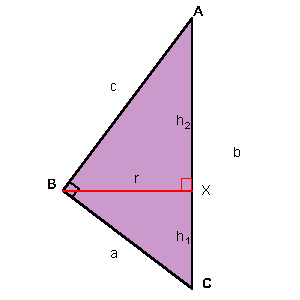Copyright © University of Cambridge. All rights reserved.
'In a Spin' printed from https://nrich.maths.org/
Show menu
Correct solutions were received from Joshua T. and Andrew I. Congratulations to both of you. I have used a mixture of the solutions to form the basis of what follows.
The first thing to observe is that by rotating the triangle about the hypotenuse I obtain two cones having the same base and opposite vertices.

To find the volume of a cone you need its height and the radius of its base. So you need to calculate the radius and the height of each cone.
$$V = \frac{1}{3}\pi r^2 h$$
The radius of the base of the cones is the altitude of the right-angled triangle ($r$), and the corresponding heights are $AX$ and $CX$.
Working directly on the general case - as it seems simpler. Let the sides of the triangle be $a$, $c$ and $b$ ($b$- the hypotenuse).
\begin{eqnarray}V &=& \frac{1}{3}\pi r^2 h \\ &=& \frac{1}{3}\pi r^2 h_{1}+\frac{1}{3}\pi r^2 h_{2}\\ &=&\frac{1}{3}\pi r^2 (h_{1}+h_{2}) \\ &=& \frac{1}{3}\pi r^2 b \end{eqnarray}
Finding the area of a right-angled triangle in two ways:
$$\frac{ac}{2}=\frac{rb}{2}$$
Therefore $$r = \frac{ac}{b}$$
Substituting for $r$ in the equation for the volume you get:
\begin{eqnarray} V &=& \frac{1}{3}\pi r^2 b \\ &=& \frac{1}{3}\pi \left( {\frac{{ac}}{b}} \right)^2 b \\ &=& \frac{1}{3}\pi \frac{{(ac)}^2}{b}\end{eqnarray}
From here you can substitute for the particular case given at the start of the problem.